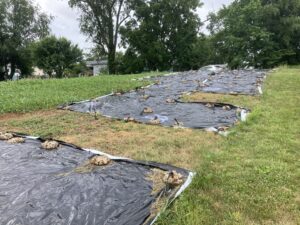Progress report for OS23-168
Project Information
This experiment will determine the amount of time required under light blocking covers to kill bermudagrass, johnsongrass, fescue and other annual and perennial weeds. By determining the time required to kill various weeds, farmers will be able to maximize productivity by uncovering and returning land to production earlier. Small market farmers report sales as high as $40,000/acre/year in intensively managed land (personal experience and communications). Over a 24-week growing season this would amount to $1666/acre/week of production. Therefore, returning land to production even a few weeks earlier could contribute significantly to farmer income.
Cam Terry of Garden Variety Harvests uses occultation or covering land with light blocking tarps to eliminate annual and perennial weeds. Local ANR agent Shawn Jadrnicek has been working closely with Cam Terry and Hunter Hartley in designing and developing Lick Run Farm site and co-teaching workshops at the farm. An old field slated for conversion to perennial and annual crops is filled with a host of perennial and annual weeds including johnsongrass (Sorghum halepense) and bermudagrass (Cynodon dactylon). The new field will be divided into 24 plots that are 6’ x 6’ in size and each plot will be marked and labeled with wire flags and analyzed between May 1 and May 15 to determine annual and perennial weed composition. On May 15, the plots will be mown and covered in light blocking silage tarps 7’ x 7’ in diameter with 12” of overlap between adjoining plots. Each plots tarp will be held down with 4 UV resistant weight bags weighing 15 pounds. Plot numbers will be assigned to each plot and the plot numbers spray painted on the silage tarp. Three Plots with similar weed species will be uncovered every two weeks starting June 1 and ending September 15. The plots uncovered will be irrigated with 20 gallons of water per plot after uncovering. Two weeks after uncovering, perennial and annual weed growth will be assessed as species and percent cover and type of regrowth (rhizome, tuber or seed) and the plots will then be recovered until September 15th. On September 15th all the plot covers will be removed and plots marked with wire flags. All plots will be irrigated and two weeks after all covers are removed, weed species and percent weed cover and type of regrowth on each plot recorded.
Cooperators
- - Producer
Research
The new field will be divided into 24 plots that are 8’ x 8’ in size and each plot will be marked and labeled with wire flags and analyzed between May 1 and May 15 to determine annual and perennial weed composition. On May 15, the plots will be mown and covered in light blocking silage tarps 7’ x 7’ in diameter with 12” of overlap between adjoining plots. Each plots tarp will be held down with 6 UV resistant weight bags weighing 15 pounds. Plot numbers will be assigned to each plot and the plot numbers spray painted on the silage tarp. Three random plots will be uncovered every two weeks starting June 1 and ending September 15. The plots uncovered will be irrigated with 20 gallons of water per plot after uncovering. Two weeks after uncovering, perennial and annual weed growth will be assessed as species and percent cover and type of regrowth (rhizome, tuber or seed) and the plots will then be recovered until September 15th. On September 15th all the plot covers will be removed and plots marked with wire flags. All plots will be irrigated and two weeks after all covers are removed, weed species and percent weed cover and type of regrowth on each plot recorded.
Twenty four plots were covered with light blocking silage tarps. The plots were made to be 8' x 8' or slightly larger than originally planned and covered with silage tarps that were 10' x 10' to facilitate overlapping of the tarping material. The tarping material was uncovered and watered at two week intervals allowing the vegetation to grow and then weeds analyzed in the plots before recovering again. A summary of the weed growth is presented in the chart above. Results indicate a longer time than anticipated for some perennial weed species to die under tarping conditions. Bermudagrass, the main weed of concern took around 14 weeks under tarping conditions to die. Johnsongrass also took around 14 weeks to die under tarping conditions. There was an edge effect on the tarps that could have contributed to weeds persisting for longer than anticipated. For example if a neighboring tarp was uncovered, potentially a perennial weed in an adjacent plot that was still covered could have been reinvigorated by the exposure to sunlight in the uncovered plot. Plot sizes were enlarged in anticipation of this effect but enlarging plot size to 15' x 15' and analyzing weeds in a smaller area in the center of the plots could mitigate the edge effect. Overall the results provide valuable information for farmers on the effects of eliminating perennial weeds through tarping and will help guide future research on this important topic.
Educational & Outreach Activities
Participation Summary:
A factsheet on occultation will be created and submitted for publication to Virginia Tech. In addition, a field day will be conducted at the farm focused on occultation.
Project Outcomes
The research conducted will allow farmers to apply tarps for specific timeframes to kill specific weeds of concern. By knowing how long they need to cover fields this will ensure the weeds of concern are eliminated as well as allowing farmers to only cover for the needed time increasing productivity and the amount of time the field is in production.
